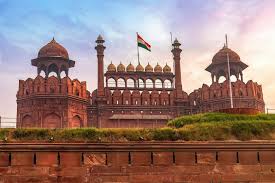Delhi, the capital of India, is a city where history meets modernity. With a rich past spanning thousands of years, Delhi is home to magnificent Mughal architecture, vibrant markets, and cutting-edge infrastructure. Whether you’re a history buff, a food lover, or a traveler seeking new experiences, Delhi offers something for everyone.
A Brief History of Delhi
Delhi has been the heart of India for centuries, serving as the capital for various dynasties, including the Mughals, British, and now modern India. From the legendary Mahabharata-era city of Indraprastha to the grandeur of Mughal rule, Delhi has witnessed the rise and fall of empires. Today, it is a political, cultural, and economic powerhouse.History of Delhi
Top Attractions in Delhi
1. India Gate
A war memorial built in honor of Indian soldiers who died in World War I, India Gate is a must-visit landmark, especially during the evening when it is beautifully lit.
2. Red Fort
A UNESCO World Heritage Site, the Red Fort is an iconic symbol of India’s history. Built by Mughal Emperor Shah Jahan, this fortress hosts India’s Independence Day celebrations every year.
3. Qutub Minar
Standing at 240 feet, Qutub Minar is the tallest brick minaret in the world. Built in the 12th century, it showcases Indo-Islamic architecture.
4. Lotus Temple
A stunning white marble temple shaped like a lotus flower, this Baháʼí House of Worship is a place for peace and meditation.
5. Akshardham Temple
One of the largest Hindu temples in the world, Akshardham Temple is known for its intricate carvings, light shows, and breathtaking architecture.History of Delhi
6. Humayun’s Tomb
Often considered the inspiration for the Taj Mahal, Humayun’s Tomb is a grand 16th-century mausoleum with beautiful Persian and Mughal influences.
7. Chandni Chowk & Old Delhi
One of the oldest markets in India, Chandni Chowk is a chaotic yet charming place filled with street food, spices, jewelry, and traditional Indian textiles.
8. Rashtrapati Bhavan & Parliament House
Delhi is the political center of India, and the grand Rashtrapati Bhavan (Presidential Palace) and Parliament House showcase the city’s colonial-era architecture.
Delhi’s Food Scene: A Culinary Adventure
Delhi is often called the food capital of India because of its diverse cuisine. Some must-try dishes include:
- Butter Chicken – A creamy, flavorful dish that originated in Delhi.History of Delhi
- Chole Bhature – A popular North Indian breakfast dish made of spicy chickpeas and fried bread.
- Parathas – Stuffed flatbreads best enjoyed at the famous Paranthe Wali Gali in Chandni Chowk.
- Street Chaat – Try golgappas (pani puri), aloo tikki, and dahi bhalla for a burst of flavors.History of Delhi
- Mughlai Kebabs & Biryani – A legacy of Delhi’s Mughal past, available at iconic places like Karim’s and Al Jawahar.
For fine dining, check out world-class restaurants like Indian Accent, Bukhara, and Dum Pukht.History of Delhi
Shopping in Delhi
- Connaught Place – A mix of high-end stores, cafes, and street vendors.
- Dilli Haat – A cultural marketplace with handicrafts and textiles from across India.
- Sarojini Nagar & Lajpat Nagar – Budget-friendly shopping for clothing and accessories.
- Khan Market – A luxurious shopping area with bookstores, designer boutiques, and restaurants.
Best Time to Visit Delhi
The best time to visit Delhi is between October and March, when the weather is cool and pleasant. Summers (April–June) can be extremely hot, while the monsoon season (July–September) brings heavy rains.History of Delhi
Delhi vs. Washington, D.C.: A Political & Cultural Comparison
Delhi and Washington, D.C., share some similarities as capitals of powerful nations:
- Political Centers – Delhi is home to the Indian Parliament, Rashtrapati Bhavan, and Supreme Court, similar to the White House and Capitol Hill in Washington, D.C.
- Historic Landmarks – Both cities feature grand monuments, museums, and cultural institutions.
- Diverse Populations – History of Delhi like Washington, D.C., attracts people from all over the country and the world.
Conclusion
History of Delhi is a city of contrasts—where ancient forts stand next to modern skyscrapers, where street food stalls thrive beside Michelin-star restaurants, and where centuries-old traditions blend seamlessly with contemporary life. Whether you’re exploring its rich history, indulging in its delicious food, or navigating its bustling streets, Delhi promises an unforgettable experience.
Would you like travel tips or recommendations for your visit to Delhi?History of Delhi


 Watch
Watch
 CASUAL WEAR
CASUAL WEAR
[…] where travel transcends the ordinary – welcome to the realm of Airbnb. From cozy cottages to luxurious penthouses, Airbnb offers a plethora of accommodation options that promise unforgettable travel […]